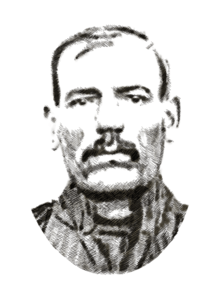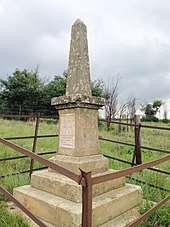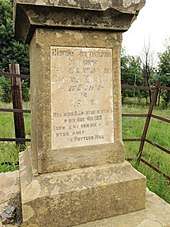Stephanus Swart
Stephanus Andries Johannes Swart (1890 – 6 May 1927) was a South African farmer and one of the first spree killers who killed at least 8 people and wounded 3 others in Charlestown, South Africa on 6 May 1927, before killing himself.[1] [2]
Stephanus Andries Johannes Swart | |
|---|---|
 | |
| Born | 1890 |
| Died | 6 May 1927 |
| Cause of death | Suicide |
| Occupation | Farmer |
| Spouse(s) | Annie Swart (née Eksteen) |
| Details | |
| Date | 6 May 1927 |
| Location(s) | Potters Hill and Charlestown, South Africa |
| Target(s) | Police and Annie Swart (wife) |
| Killed | 9 (including himself) |
| Injured | 3 |
| Weapons |
|
Timeline
Police pursued Swart one day after he fired a shot at his neighbour, Mr Lourens, on 3 May 1927 for no apparent reason. At some point Swart summoned his attorney and ordered him to write down Swart's 28-page suicide statement after setting his own car on fire and hiking 10 miles to his farm house.
Swart was confronted by a police constable in the early hours of 6 May at his home with a warrant for Swart to give himself up. Swart replied that he simply wanted an oak coffin and wanted it to be zinc-lined, and he would shoot anyone who came through the road running near his property after 6:00 pm. The alarmed constable immediately started to gather a posse of a dozen policemen led by inspector Ashman to arrest Swart the next day.
Swart killed five officers (including Ashman) and wounded another near his farm, taking the inspector's revolver and horse. He went to a nearby house to tell his neighbour that he intended to go into Charlestown to kill three more people before going to Volkrust to kill himself. The neighbour departed to warn police of Swart's coming. His neighbour, Swanepoel, when nearing Mount Prospect, was approached by a black person with a note from Swart saying he would return to kill him after he completed his "mission". By now Swart had killed two more people on the road, Fannie Knight and G. Roets. They had testified against him for incest for which he had been convicted and sentenced to several months in prison.
Swart arrived in Charlestown across from the train station at a house where his estranged wife was living. Swart gunned down his wife, then rode his stolen horse to the edge of town and fired at a passing automobile, wounding the driver and a passenger. At this point police all over the district had been notified and had formed a posse of local farmers along with police to hunt him down. Swart was spotted diving into a ditch after an officer fired at him. A final shot was heard, as Swart killed himself with the stolen Webley Revolver.
Victims
Policemen
- Inspector Gerald C. Ashman
- Constable William H. Crossman
- Sergeant J.A. Grove
- Head Constable William Charles Mitchell
- Sergeant Annes van Wyk
Witnesses at previous trial
- Fannie Knight (step daughter)
- G. Roets[3]
Estranged wife
- Annie Swart
Monument


A memorial on the location of the murder of Fanny Knight reads "Hierdie Gedenkteken is opgerigt ter gedagtenis aan Fannie Knight -nee Eksteen- en C. Roets, wat deur S. Swart geskiet was op die 6de Mei 1927, terwyl hy van die polisie ontsnap het to Potters Hill" (This memorial is erected in memory of Fanny Knight -nee Eksteen- and G. Roets. Who were shot by S. Swart on 6 May 1927 while he had escaped from the police at Potter's Hill).[3]
References
- https://www.netwerk24.com/ZA/Bloemnuus/Nuus/die-slagtings-wat-die-wereld-ruk-20170315-2
- "On May 3rd 1927, Stephanus Andrias Johannes Swart... | Crime, Not Forgotten". Crime, Not Forgotten. Retrieved 14 November 2018.
- "Fanny Knight Memorial details". www.artefacts.co.za. Retrieved 22 June 2018.
External links
- Seven Slain as Farmer Runs Amuck [sic], 7 May 1927. "Seven Slain as Farmer Runs Amuck. CAPETOWN, South Africa May 6 -Seven were killed and two wounded in a shooting affray at Charlestown, on the frontier of Natal, when a farmer ran amuck in resisting arrest. The farmer took refuge behind a stone fence after shooting and wounding a constable. Police surrounded him, but he eluded them , entered a near-by village and shot indiscriminately, finally killing his wife and commiting suicide.",
- Couzens, Tim: Battles of South Africa; David Philip Publishers, 2004. (pp. 207–15); ISBN 0 86486-621 6
- Marsh, Rob: Famous South African Crimes; Struik Timmins, 1991 (pp. 24–29); ISBN 0869784390